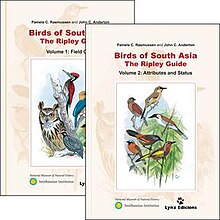Birds of South Asia. The Ripley Guide
 |
|
| Author | Pamela C. Rasmussen and John C. Anderton |
|---|---|
| Illustrator | Anderton and eleven other artists |
| Cover artist | Anderton |
| Country | U.S. |
| Language | English |
| Publisher | Smithsonian Institution and Lynx Edicions |
|
Publication date
|
2005 |
| Media type | Print (Hardback) |
| ISBN | (both vols.) 84-87334-65-2 (vol. 1) 84-87334-66-0 (vol. 2) |
| OCLC | 433009160 |
Birds of South Asia. The Ripley Guide by Pamela C. Rasmussen and John C. Anderton is a two-volume ornithological handbook, covering the birds of South Asia, published in 2005 (second edition in 2012) by the Smithsonian Institution and Lynx Edicions. The geographical scope of the book covers India, Bangladesh, Pakistan, Sri Lanka, Nepal, Bhutan, Maldives, the Chagos archipelago and Afghanistan (the latter country had been excluded from previous works covering this region). In total, 1508 species are covered (this figure includes 85 hypothetical and 67 'possible' species, which are given only shorter accounts). Two notable aspects of Birds of South Asia are its distribution evidence-base — the book's authors based their distributional information almost completely on museum specimens — and its taxonomic approach, involving a large number of species-level splits.
Volume 1 is a field guide. A nine-page introduction is followed by 180 colour plates, each with an accompanying text page giving brief identification notes, and, for most species, range maps. In addition to the 69 plates by Anderton, eleven other artists contributed, including Ian Lewington and Bill Zetterström. Volume 2: Attributes and Status contains more detailed supporting texts for every species. Twelve other authors are listed as having contributed to this volume, including Per Alström, Nigel Collar and Craig Robson. This volume opens with an appreciation, written by Bruce Beehler, of S. Dillon Ripley, who initiated the work which led to the book, and after whom it is named. This is followed by a 24-page introduction. The bulk of the book, from pages 41 to 601, consists of individual species accounts; each of these includes sections on identification, occurrence, habits and voice (this latter section accompanied by sonograms for many species). There are ten appendices, including a hypothetical list, a list of rejected species, a summary of taxonomic changes, a glossary, a gazetteer, and a list of institutions holding major collections of South Asian bird specimens.
...
Wikipedia
